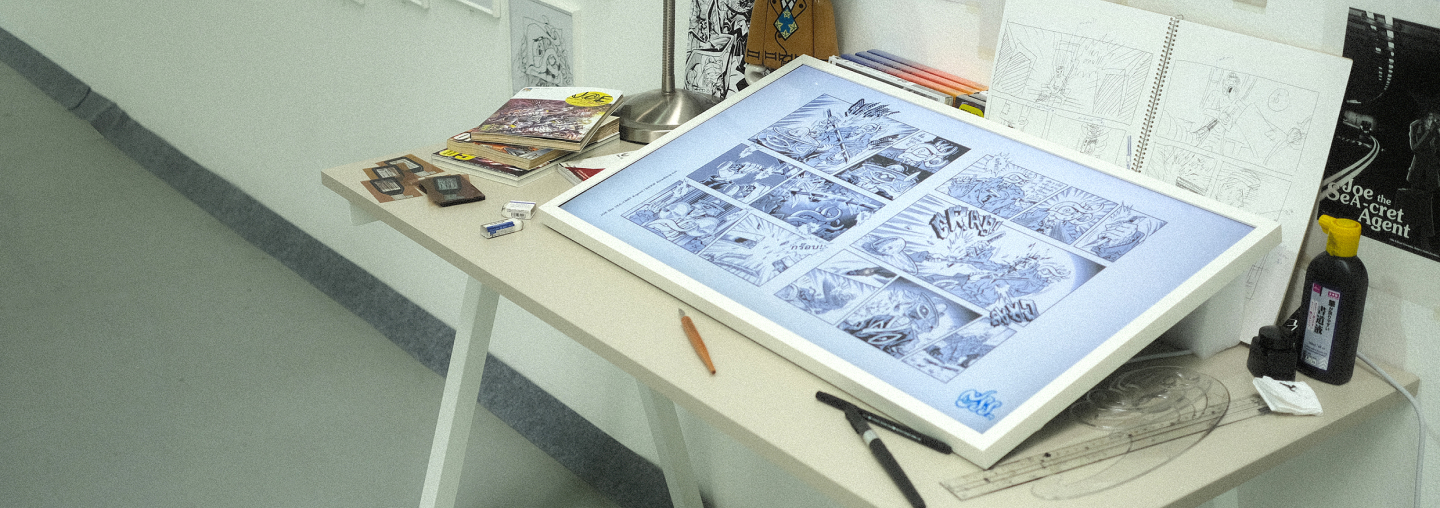
50JOEs : The Value Shift of Illustration Art
Mr. Suttichart Sarapaiwanich
Introduction :
Today the medium of art is very varied, from traditional like painting, drawing, and sculpture, to digital art like NFT. The value of art in these different areas already changed from the past. Now the physical of art isn’t part of the value that shifts into many ways depending on the exhibit platforms that give many opportunities for every artist to explore but it is also a problem for some artists who can’t adapt to the new areas or technologies that will decrease the original value of their work or possibly disrupt their careers. But art
value factors are more complex than just choosing the right medium or platform. The artwork is the product that depends on emotion between the artist and the collector. The value of digital art in a .jpg file can have more value than a wall-sized painting.
The 50JOEs project is the experiment to find the right area of the art from the comic JOE the SEA-CRET Agent that starts from the fifty of original art on the papers by hand like the original work in traditional comic creation processes. The fifty original artworks are exhibited in plastic frames as packaging and also adapted to limited print to fifty artbooks that print the originals in the same size and quality and the last adaptation is fifty NFT art on the Opensea platform. The original artworks exhibited at Bangkok Illustration Art Fair 2022 at BACC sold out a week before when the online sale also stated the fifty art books, but the NFT only sold 9 pieces simultaneously.
The result of this experiment has shown that the value of art today is different from many factors around the project such as the behavior of the collector or target group, the supported story behind the project, gimmick idea, promotion plan, social network viral, proper technology in that time and place, etc. So, the value of the artwork from the comic JOE the SEA-CRET Agent has been connected to the original comic book but it’s hard to sell by the NFT platform because the collector or target group of this comic don’t interest in this technology now and the law about selling a digital asset like NFT is still unclear in Thailand at the time of this experimental project.
Objectives:
The objectives of this project:
1. To find the best platform to exhibit the illustration art from the original comic
2. To balance the value of artwork and the budget in the different medium
3. To connect the reader of the comic and the collectors in the same exhibition
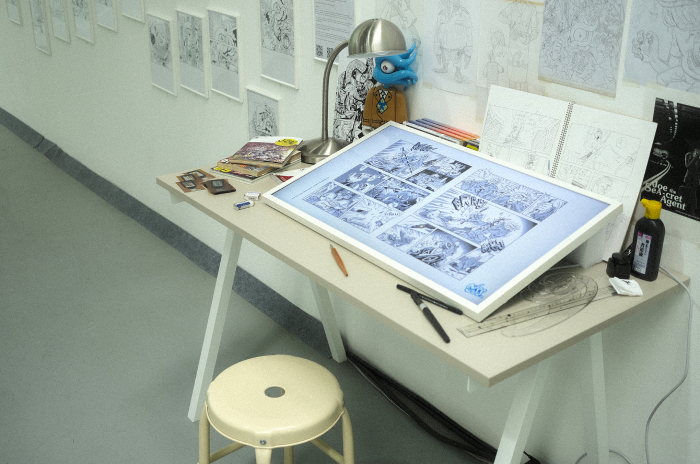

Methodology:
Art isn’t like any goods or product because the value of art depends on the satisfaction between supply and demand that is the artist and collector. The cost of art production isn’t the only factor of value when the art is finished. The hidden factors included the artist’s reputation, the popular style, the new revolution, the concept, the semeiotic, or anything in that time. So we can’t specify any art at the exact price or predict which art is expensive or cheap ourselves. But how do we set the value of art?
“In trying to identify the form of value specific to art we need to distinguish it from other forms of value in the vicinity:
– From economic values such as utility and price.
– From epistemic values such as truth and ethical values such as goodness.
– From subjective values such as personal preference.
Nevertheless, we need to understand what all of these have in common. We need to describe the genus of value as such if we are to describe the species of value that distinguishes art. The key idea is this: value is what provides reasons for action.” (Wolfendale, 2017)
The original value of a comic book is on the printing book by the publisher in the traditional business before adding the online version to read on digital equipment later by the development of technology and the reader behavior. But in Thailand, only the sale percentage from the comic book published isn’t enough, so many comic artists try to find another way to support their expenses and promote their work together. The art exhibition is the answer to the comic JOE the SEA-CRET Agent.
Fine art and illustration share the same root but different goals between pure and commercial art in the past, but the border is blurred when pop art is happening. “The difference between commercial art and fine art was pretty clear up until the mid- 20th century. Commercial art included television and print advertisement campaigns, as well as mass-produced images. Fine art consisted of one-of-a-kind unique objects such as paintings, sculptures, and works on paper that was exhibited in galleries and museums.
Then the art movement known as pop art subverted and merged those diverse aims in the 1960s. Pop artists such as Andy Warhol mass-produced images using the tools of commercial artists. Warhol’s silkscreened Brillo Boxes is a memorable example of how commercial art merged with fine art.” (Kendzulak, 2019)
In the past, the artist must find a gallery to exhibit their works or the curator to be a connection between them. But in the 2020s, the occurrence of NFT art on the digital platform with blockchain technology to prove the original quantity of digital art turned out to be another space for exhibiting the art from any artist. “Digital art was born in the 1960s, but the 2020s will surely go down as the era when the medium came into its own and turned the art industry upside down in the process.
Technology, in the form of non-fungible tokens (NFTs) such as CryptoPunks, has played a key role in disrupting traditional art-market dynamics. Online marketplaces and platforms have enabled artists to dispense with gatekeepers, birthing a billion-dollar business that favors creators.” (Hamacher, 2022)
For the comic JOE the SEA-CRET Agent, the artist exhibited the illustration in the gallery many times as a solo and group. When the NFT was popular in Thailand, the artist creates the original comic art into NFT art and sell in many platforms to study the best space and the behavior of the collectors in the NFT area. The NFT sale is succeeded on some platforms, but the problem is collectors outside Thailand can’t connect to the original comic.
The other problem is the reader or collector of this comic isn’t interested to buy NFT for many reasons such as the understanding of blockchain technology, the lack of a digital skillset, or the misunderstanding of NFT and gambling or scamming. “Another issue with NFTs, owing to the fact that the same decentralized nature that drives cryptocurrency also drives NFTs, stems from how it’s a highly unregulated market. And just like any unregulated market, it’s a prime space for fraudulent actors to pull scams and do whatever they want.
In the NFT space, we’ve seen everything from rug pulls to pump and dump schemes to straight-up thefts and everything in between. There’s no governing agency of any kind to stop scams from taking place, and there’s no one who can step in to help you if you lose your hard-earned money—short of getting law enforcement and courts involved if it comes to that. Coming in as an NFT investor means that there are heaps of things to consider before investing in an NFT or risk losing thousands of dollars to a scammer.” (Wright, 2022)
The stakeholder of the comic JOE the SEA-CRET Agent included readers, collectors, and people who have known the comic in different media, so the question is what is the best platform for exhibiting the art from this comic? The 50JOEs project has been started by this question. The project selected the main protagonist and the most famous character in this comic named JOE for use in 50 art pieces by 3 mediums 1. Original comic-style artworks 2. Limited prints art book of original artworks 3. NFT art from original artworks for observing the best area for exhibiting this comic art style.
After finishing fifty artworks on paper, then transform them into printing and NFT. The framed fifty originals are exhibited at Bangkok Illustration Fair 2022 as the work of official guest artists. The all-mediums sale plan started with a surprise post on the social network a week before the exhibition. After a couple of hours, the fifty original artworks sold out then the fifty printing but the NFT sold only 9 pieces.
For the exhibition, this project designs the mock artist table to connect the background story of when this comic was created and is well-known by many readers with the fifty original framed artworks on the wall. The mock table has a TV screen that plays the loop video of every
comic page to simulate the process of comic creation and decorate around with the comic tools.
Techniques and Materials:
The 50JOEs project separated into 3 platforms
1. Original art by ink drawing on paper like the traditional comic creation processes. Each one is exhibited in a ready-made plastic frame as packaging for collectors.
2. Limited art book printing in the same size and quality as the original art by digital print.
3. NFT art at Opensea platform that each one added the screen tone to the original art to complete like the traditional comic pages.
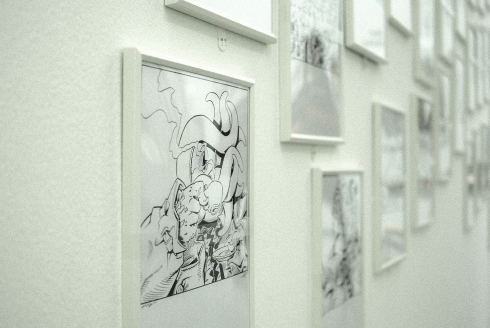
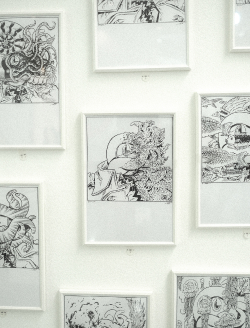
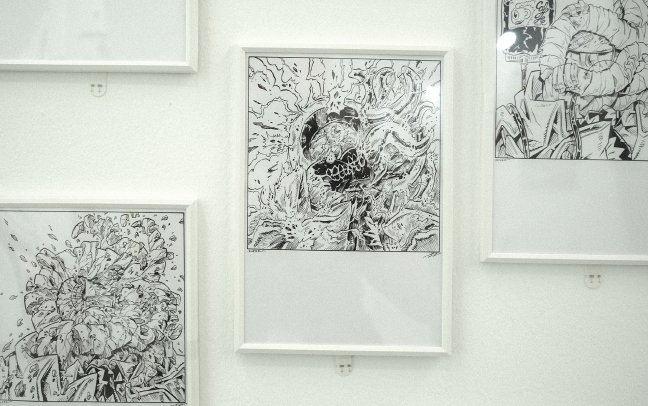
Conclusion:
The result of this experiment has shown that the value of art today is different from many factors around the project such as the behavior of the collector or target group, the supported story behind the project, gimmick idea, promotion plan, social network viral, proper technology in that time and place, etc. So, the value of the artwork from the comic JOE the SEA-CRET Agent has been connected to the original comic book but it’s hard to sell by the NFT platform because the collector or target group of this comic don’t interest in this technology now and the law about selling a digital asset like NFT is still unclear in Thailand at the time of this experimental project.
References:
Kendzulak, S. (2019, June 25). The distinction between commercial and fine art.
LiveAbout. Retrieved February 20, 2023, from https://www.liveabout.com/commercial- vs-fine-art-1295902
Hamacher, A. (2022, May 12). NFTs started ‘A digital art renaissance.’ it’s far from over. Decrypt. Retrieved February 20, 2023, from https://decrypt.co/99301/nfts-started-a- digital-art-renaissance-its-far-from-over
Wright, A. (2022, June 28). Why do people hate nfts so much? 5 reasons explained. MUO. Retrieved February 20, 2023, from https://www.makeuseof.com/why-people-hate- nfts/#:~:text=It’s%20an%20Unregulated%20Market,and%20do%20whatever%20they% 20want.
Wolfendale, P. (2017, December 18). Art and value. Academia.edu. Retrieved February 20, 2023, from https://www.academia.edu/35461191/Art_and_Value